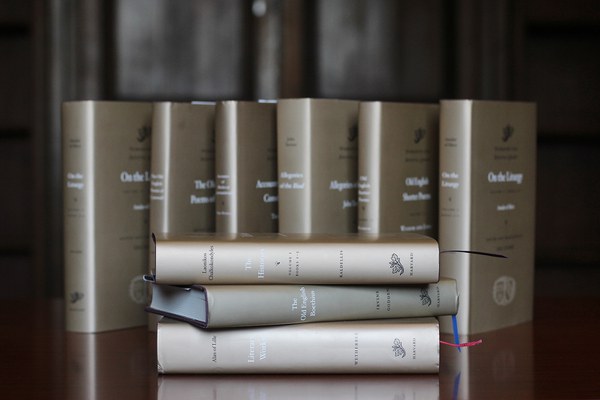By Nicole Eddy
In November of 2010, the Dumbarton Oaks Medieval Library (DOML) published its first volumes. Founded by Jan M. Ziolkowski, director of Dumbarton Oaks from 2007 to 2020 and the series’s first general editor, these facing-page translations have a simple goal: to bring medieval Latin, Byzantine Greek, and Old English literature to a broader audience of scholars and general readers. The compact volumes, in imperial purple covers with gold jackets, are designed to stand beside the green and red covers of DOML’s century-old sister series the Loeb Classical Library, as a similar testament to the flourishing of Latin, Greek, and vernacular literary culture across the premodern period. During the 2020–2021 academic year, DOML proudly celebrates ten years of high-quality, affordable translations, and looks forward to one day celebrating its own century mark.
The year 2010 saw a triumphant start: the Latin subseries produced the first three of the seven-part Vulgate Bible (the remaining volumes came out over the course of the next two years), The Rule of Saint Benedict, and an anthology of twelfth-century Latin poetry covering topics ranging from secular love to ecclesiastical satire. As one of many firsts in the series, The Vulgate Bible brings together Jerome’s famous fourth-century translation—the standard version of scripture for medieval Latin Christendom—with the sixteenth-century English version known as the Douay-Rheims translation, produced shortly before the King James Bible by exiled English Catholics. This is the first publication to present Jerome’s Latin and the Douay-Rheims en face. The Rule of Saint Benedict is arguably second only to the Vulgate in its profound influence on Western medieval life and, certainly, its religious culture. A handbook to regulate the monks’ daily life in Benedict’s fledgling sixth-century religious foundation outside the Italian town of Cassino, it became the key model for monastic life over the subsequent centuries. Meanwhile, translations of The Arundel Lyrics and The Poems of Hugh Primas represent the subseries’s first foray into belles lettres, with all of medieval scholastic poetry’s characteristic wit, classical allusion, and Ovidian views of love and seduction.
The Old English subseries started off with its own first. Over its long publication history, the famous epic Beowulf had never before been printed with the other four texts that accompany it in its single manuscript. Still the series’s most popular volume, The Beowulf Manuscript has as its centerpiece the tale of a Scandinavian warrior who defeats two cannibalistic monsters in his youth and later, in old age, vanquishes a dragon but loses his life. Reunited with Beowulf in the same volume are the manuscript’s other narratives, including the tale of Judith and Holofernes, a fanciful description of Alexander the Great’s exotic encounters in India, more exotic encounters in The Wonders of the East, and the story of Saint Christopher. Readers discover Beowulf as its medieval audience would have known it, in the context of contemporary literary traditions and an imaginative view of the wider world. The second volume in the Old English subseries, Old Testament Narratives offers poetic accounts from the biblical books Genesis, Exodus, and Daniel. The familiar stories are reworked with imaginative daring, so that Moses, for example, appears like a Germanic warrior king leading his people in an exodus across a terrain that resembles northwestern Europe far more than the lands around the Red Sea.
Miracle Tales from Byzantium (2012) was the first in what are now seventeen titles (nineteen volumes) in the subseries that delivers Byzantine Greek literature to new audiences. These Miracle Tales range from the unabashedly mythic (Saint Thekla battling mountains or driving Zeus from the city and converting his temple to a church) to the more mundane (the emperor Justinian, healed of pain in urination by a curative regimen of cold water from the Virgin Mary’s shrine). But what they have in common is a view on the construction of Byzantine sainthood that’s both literary and historical.
As it moves into its eleventh year, DOML continues to offer a diverse range of new titles including, this spring, a chronicle of political infighting at a Swiss monastery, the sometimes salacious stories and fables of The Byzantine Sinbad, and, in what will be our sixty-ninth volume, the abundantly diverse Old English and Anglo-Latin Riddle Tradition. Looking ahead to our next ten years, we are committed to continue offering medieval and Byzantine literary treasures to fresh audiences.
Shop all these titles and more at domedieval.org.
Nicole Eddy is managing editor of the Dumbarton Oaks Medieval Library.

